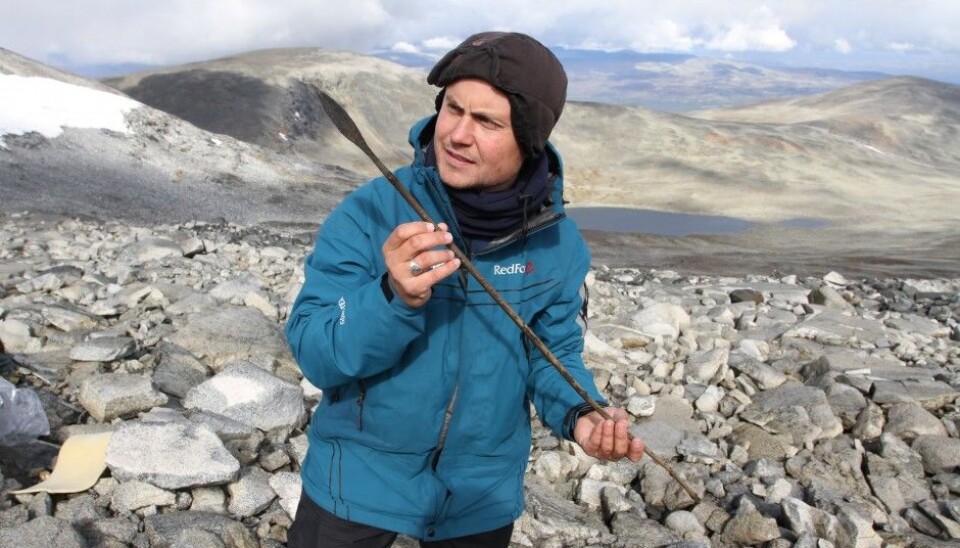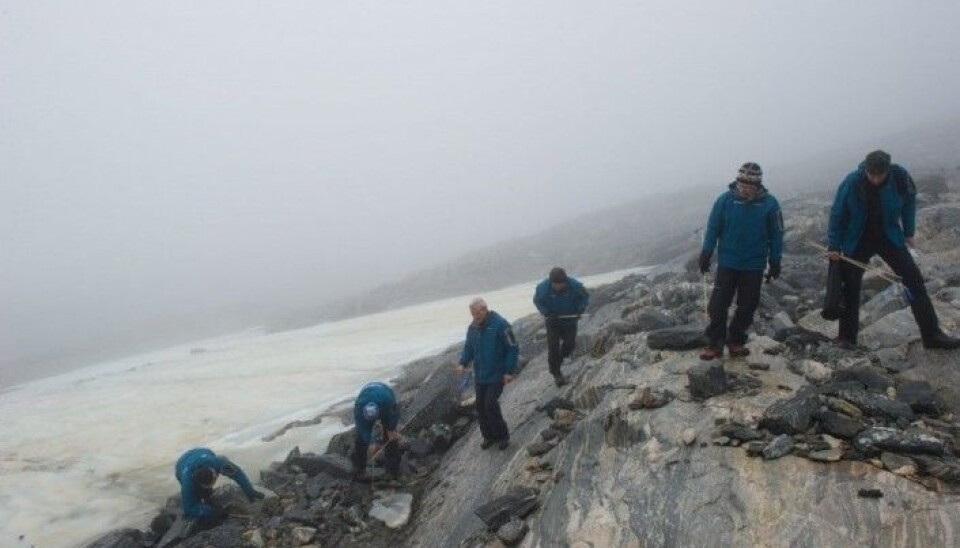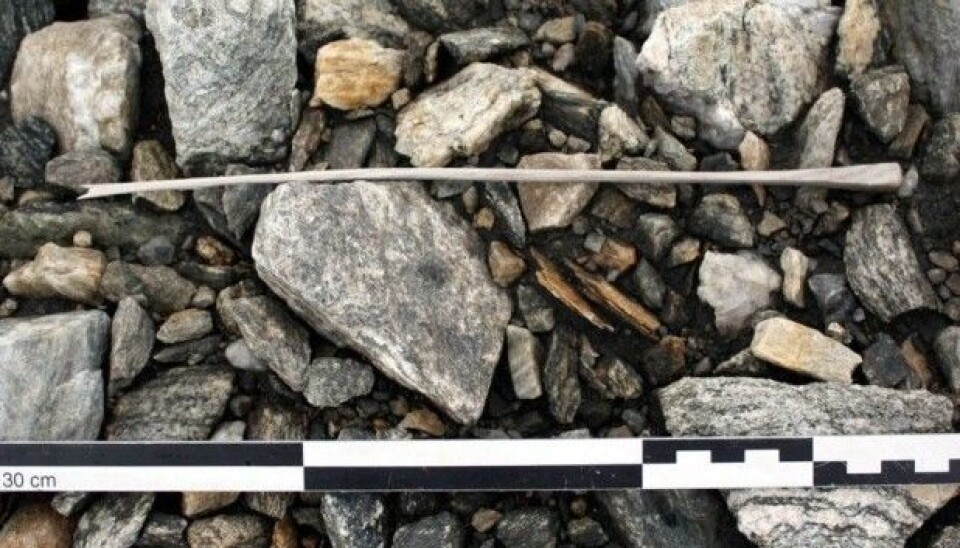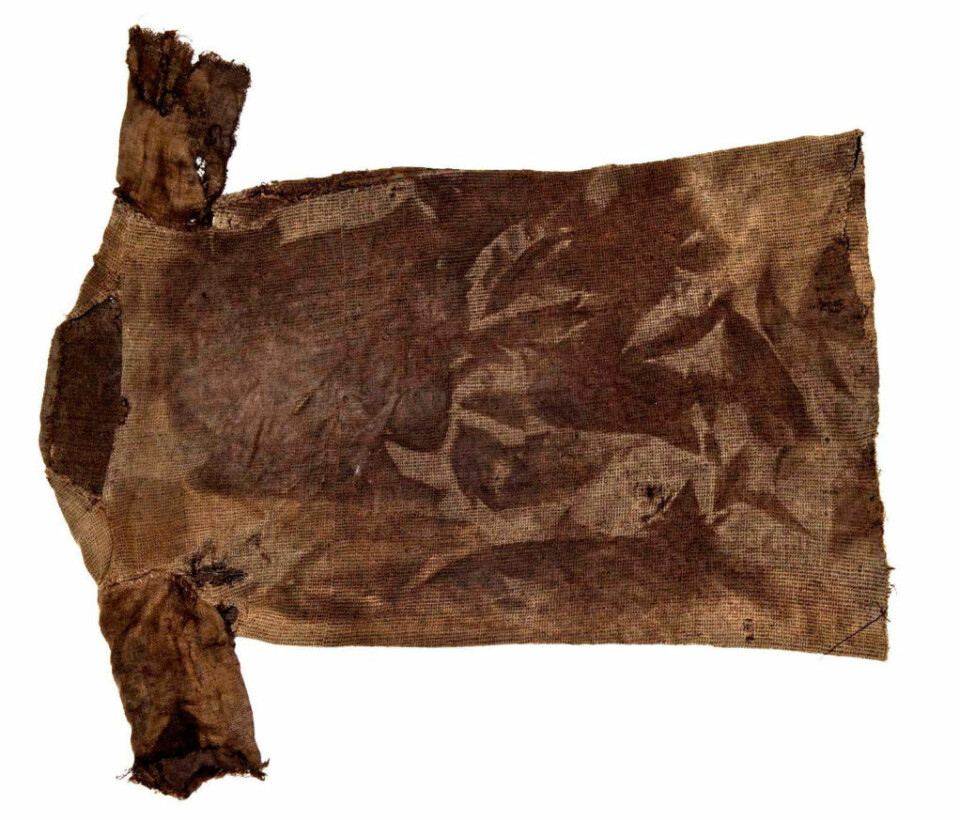
Discoveries from 1,400-year-old ice surprise scientists
A fierce cold period struck the Northern Hemisphere in the years from 536 AD to the 660s AD with no real summers. It became known as the Fimbulvinter – The Terrible Winter – and worked its way into Norse folklore. Now archaeological discoveries from this period reveal how people in Norway survived these tough years and researchers are surprised by the finds.
Ten years ago archaeologists started systematically collecting artefacts that were turning up under Norwegian mountain glacial ice and perennial snow fields that have been frozen for as long as thousands of years.
The archaeologist Lars Pilø, now titled a glacial archaeologist for Oppland County, has been involved in this new field of work in Norway from the start. Since 2007, he and his colleagues have conducted field work in the county’s glacial areas every summer and collected objects that
Norwegians’ ancestors have lost or left behind, now turning up in and near the retreating fields of ancient snow and ice. In 2016 they were accompanied by forskning.no journalist Lasse Biørnstad .
An ancient trail crossed the mountains at Lendbreen, one of the glaciers where Lars Pilø and colleagues have conducted fieldwork. This was a route between Sognafjord on the West Coast and Eastern Norway. People have travelled between Skjåk and Bøverdalen, with livestock and to summer mountain farms, or simply to get from one place to another. The scientists have found mittens and skis, a horse skull and hiking staffs from the Viking Age.
They have found over 2,000 artefacts in Oppland County alone. Many of these were used in hunting. Some have lost them by accident or they could have discarded them if they were damaged. The archaeologists have found arrows, bows, clothes, horse equipment and horse dung.
Pilø and some of his fellow researchers have recently published a research article in the journal Royal Society Open Science providing a summary of where they have found artefacts and how old 153 of them are.

The researchers used radiocarbon dating of their finds to draw a timeline for the artefacts, the most ancient being 6,000 years old. This has given them an idea of which periods in older Norwegian history people have travelled and hunted in these mountains and when and perhaps why there was less human activity at these elevations at other times.
Surprising numbers from extremely cold period
They were surprised by what they discovered from layers of snow and ice formed in period of climate change from 536 to about 660 AD. This extensive cold period is known as the Late Antique Little Ice Age.
One might expect that traces of human activity high in the mountains would decrease during these decades of a colder and harsher climate, as seen in other parts of Norway during this period. These were certainly hard times in Northern Europe and the population plunged. Yet this is not reflected in the quantities of artefacts testifying to hunting and other activities found by Pilø and colleagues in the Oppland County mountains.
Pilø was amazed to see signs of increased activities and thinks it could be the result of people adjusting to the climate as well as they could.
“What we need to remember is that those who lived in the North Gudbrandsdalen region then an up until modern times were not either farmers or hunters. They were both. Additionally, this is a rather marginal region for agriculture, so even small changes in climate tend to have quite an impact here.”
“When people saw their agricultural yields declining the solution was to hunt more. Maybe this is the readjustment we are seeing traces of now in the artefacts from the ice of that period. A comparable development is found regarding the Norse settlers on Greenland at this time. They started hunting more when the climate got colder.”
A child’s practice arrow
The architects also find traces of children’s lives among the items from 6th century Norway. They discovered an arrow so small that it must have been used by a child who was also up in the mountains. Maybe the child was brought along to learn how the adults hunted reindeer.
The arrow is just 26 centimetres long, and the archaeologists have contacted experts who are sure this was a play arrow.
“It was just for practicing. Hunting must have been a crucial thing for kids to learn in this period,” says the glacial archaeologist. He was delighted to find something related to children, as this provides a closer look into the lives of these ancestral Norwegians.
“This was a tough time to live. Perhaps a child was practicing and lost the arrow. The child would have been very unhappy about its disappearance. But it didn’t vanish. The ice preserved it for 1,400 years,” says Pilø.
Many finds because of larger glaciers?
University of Tromsø Paleo-ecologist, Per Sjögren, is a specialist in searching for signs of ancient life and has found traces of the so-called Fimbulvinter of the 6th century by analysing changes in the cultural landscape of the Norwegian mountains.
He too is taken aback by Pilø’s and fellow researchers’ discoveries of increased human activities during the Late Antique Little Ice Age at high altitudes in the 500s and 600s.

“Yes, we know that agricultural activities decreased in the mountain areas, and with a highly probable decline in population and no other evidence, I would have expected all activity in the mountain areas to have been reduced too,” he writes in an e-mail to ScienceNordic’s Norwegian partner, forskning.no.
He likes the hypothesis that people relied more on hunting when their crops took a beating because of the cooler climate.
But Sjögren points out that glaciers expanded in this period and this has an effect on where the archaeologists finds artefacts and how well they are preserved.
Pilø says this is a natural consideration, which the archaeologists have had previously and which they discuss in their research publication.
“We do not see a pattern of more discoveries when the glaciers grow. One of the reasons for this is that most of the findings are from perennial patches of snow, not from glaciers, and these react in their own way to climate variations,” says Pilø.
The researchers from Oppland County, the University of Oslo Museum of Cultural History and the University of Cambridge have attempted to place 153 artefacts on a timeline in their article. Pilø and colleagues explain this more in a video on the Facebook page Secrets of the Ice.
Rises and dips
The researchers have also found considerably older items, including an arrow that melted out of the ice layers which has been dated at 3800–4000 BC. After that there is a long hiatus of nearly 1,600 years where they find no artefacts preserved in the ice.

The researchers write that what they find amongst the oldest articles is probably a reflection of how good the conditions were for their preservation. Prior to 4000 BC, the climate was warmer and there might have been little ice in the Oppland mountain region. Organic items people lost or intentionally left behind would not be preserved.
This has caused a gap from 3800 to 2200 BC. The researchers reason that way up at the highest altitudes there could still be some artefacts from this period trapped in ice, but further down the slopes they could have melted out centuries ago and thus lost.
Then things start turning up again – the researchers find things from after 300 AD and as mentioned from the cold climate period two to three centuries later.
The archaeologists find many artefacts from 700–900 AD, just prior to and during the Viking Age.
“This was because of an increase in trade,” says Pilø. Hunting and trapping products, such as hides and antlers, found a market outside the region.
Pilø says that one might expect finds of artefacts from hunting to increase all the more during the Middle Ages, but they don’t.
“On the contrary, the quantity of artefact discoveries drops off. We think the reindeer population was almost wiped out during the Middle Ages. People had started using mass trapping techniques which were unsustainable.”
Strides in glacial archaeology
Glacial archaeology is a fairly new field. The first journal dedicated to the field, the Journal of Glacial Archaeology, started up in 2014. Artefacts from ancient mountain people are found in the Rocky Mountains, the Andes and the Alps.
Pilø views his team’s latest research article in Royal Society Open Science to be something of a summary of their work in recent years. He thinks the field has made great strides.
“We have come a lot further. We are starting to get a strong overview of where there are findings and we understand more about the sites. In 2006 the work was in what we could call a panic stage. We simply tried to save as many items as possible that melted out of the ice and get them into a museum for conservation. Now we see from mappings that they are found in certain places more than others, and more is found where there are solid patches of snow near a settlement.”
“Since 2011 we have a programme with ongoing funding from the Ministry of Climate and the Environment and others, so we can work systematically. This extends our understanding.
Mixed feelings
In an article in forskning.no from 2014, Pilø said it was thrilling to find everything from hunting tools to daily life articles like mittens and shoes, bones from horses that died on the trail across the mountains in the distant past. But the sweet discoveries could be said to have a bitter aftertaste in these times of worries about global warming.
“The artefacts can give us new knowledge about people who have lived here since the Stone Age. This is undeniably exciting. At the same time, the material is turning up so fast from melting snow and ice that archaeologists need to work as fast as they can to save and conserve them as well as nature has done up until now,” said Pilø to forskning.no four years ago.
——————————————————-
Read the Norwegian version of this article at forskning.no.
Translated by: Glenn Ostling






























